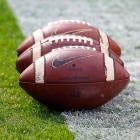Flag football should be the national standard for competition until high-school age, according to a study released Wednesday by the Aspen Institute Sports and Society Program.
In a white paper, the institute concludes that a combination of less contact and the teaching of proper tackling techniques will improve the quality and safety of football.
"This debate has been pushed to the forefront because it's clear how much more is at stake now," the institute states, "starting with brains of children, which need to function effectively and efficiently to thrive in the new, information-based economy."
Specifically, the institute recommends …
- USA Football, Pop Warner and all other youth football organizations shift to a standard of flag football before age 14.
- Those same organizations begin teaching fundamental blocking, tackling and hitting techniques at age 12.
- High school and colleges minimize non-game tackling and player collisions by adopting Dartmouth-style instruction and practice standards.
- The football industry -- including high schools and colleges -- expand their flag football offerings.
The recommendations follows the trend in several states that have at least introduced legislation to limit the amount of full contact for youths. California, Illinois, New York and Maryland have proposed age restrictions.
None of the bills have passed.
"We think a lot of that is based on very one-sided, very narrow research without any control group," Jon Butler, executive director of Pop Warner youth football, told CBS Sports. "There is no evidence that starting tackle football at any given age causes any particular problems."
Football coaches at every level have already discussed the issue, according to Todd Berry, executive director of the American Football Coaches Association.
"When is the appropriate time to begin playing tackle football?" Berry said rhetorically. "The majority believe that tackle football begins too early and that flag football is the correct means to begin the game. Where our coaches have not been able to come to a consensus is what is the appropriate age to begin tackle football. We have withheld because of the minimal number of large studies and the medical community not coming to a consensus."
The institute began digging down on the subject with a series of discussions beginning in January. It cites research that shows the number of players in high school football shrank for the fourth consecutive year in 2017 to 1.07 million.
Participation among children ages 6-12 has fallen more than 17 percent over the last five years. The UMass-Lowell Center for Public Opinion Research in 2016 found 78 percent of adults do not think it is appropriate for children to participate in tackle football before the age of 14.
There are 10,000 fewer students playing football in the state of California since 2015, the Los Angeles Times reported in August.
The Dartmouth-style technique has been widely discussed. In 2016, Ivy League coaches decided to eliminate full-contact hitting during the regular season.
"I think there's way too much contact at any level," Dartmouth coach Buddy Teevens said in the study. "I think coaches are the ones who drive it. [When] I spoke with [the] American Football Coaches Association, I said that our collective body can fix this right now. We design practices. We approve drills. We say yes or no. If we push contact and aggressiveness, our players are going to reflect it and they're going to get hurt.
"It's a real simple equation: The more you hit, the more you will get hurt. [So] minimize contact."
The NCAA has reduced the number of practices in the spring and fall in recent years. Two-a-day drills in fall practice were eliminated in 2017.
The association declined comment on the Aspen study.
Several head coaches at major programs on their own have decreased the number of full-contact practices. Since 2013, the Pac-12 has allowed a maximum of two full-contact practices per week during the regular season.
North Carolina coach Larry Fedora said in July that "football is under attack," suggesting that if the current culture of the sport changes "[that] would be the decline of our country."
















